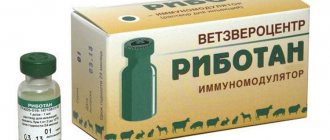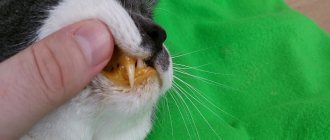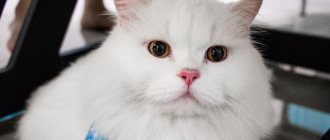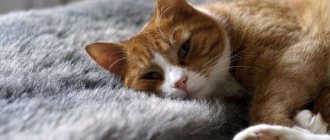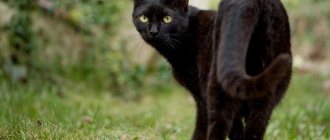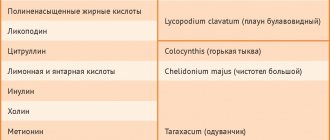Compound
The main active ingredient of the drug is human interleukin-2, which is produced by genetically modified yeast. Auxiliary components are the following substances:
- Sodium lauryl sulfate (dodecyl sulfate) is a solvent.
- D-mannitol is a stabilizer.
- Ammonium bicarbonate is an acidity regulator.
- Ditriothreiol is a reducing agent.
- Aqua about injectionibus (water d.i.).
The appearance of the drug is a yellowish or colorless liquid.
Ronkoleikin
Description
Roncoleukin for animals is an injectable immunomodulator, is a dosage form of human rIL-2 (recombinant interleukin-2), isolated and purified from yeast cells Saccharomyces cerevisiae (Baker's yeast), with the addition of the following excipients D-mannitol, SDS (sodium dodecyl sulfate) and DTT (dithiothreitol).
One ampoule contains recombinant human interleukin-2 0.05; 0.1; 0.25 or 0.5 mg (50,000, 100,000, 250,000, 500,000 IU). As excipients, 1 ml of the drug contains: D-mannitol – 2.5 mg/5 mg/12 mg/25 mg/50 mg, sodium dodecyl sulfate – 0.5 mg/1 mg/2.5 mg/5 mg/ 10 mg, dithiothreitol – 0.08 mg, ammonium carbonate – 0.79 mg, water for injection up to 1 ml.
One bottle contains recombinant human interleukin-2 2 mg (2,000,000 IU). As excipients, 10 ml of solution contains: D-manitol - 100 mg, sodium dodecyl sulfate - 20 mg, dithiothreitol - 0.8 mg, ammonium carbonate - 7.9 mg; water for injection – up to 10 ml.
Release form
Roncoleukin is available in the form of a solution for parenteral, intranasal, external and oral use. In veterinary pharmacies you can purchase 1 cm3 ampoules, as well as 10 ml bottles, closed with rubber closures and protected with metal caps. The concentration of the active component can be different; for ease of use, ampoules of 100 are produced; 250 and 500 thousand IU.
Ronkoleikin
The active component of the drug affects T-lymphocytes, which form cells that kill pathogenic microorganisms and destroy cells of tumor tissues. Therefore, the immunocorrector is simultaneously an antibiotic, antimycotic and anticarcinogen.
Purpose
The drug is prescribed to mammals, birds, reptiles, and fish for immune correction of the body in the following situations:
- Treatment.
- Prevention:
- Contagious diseases.
- Purulent wounds.
- Oncology.
- Elimination of stressful situations.
- Prevention of post-vaccination complications.
- Stimulation of antibody production after immunization.
- Accelerating healing after surgery.
- Improving the immune status of older individuals.
Methods of application
30 minutes before use, the drug solution is warmed at room temperature so that dodecyl sulfate, which crystallizes during storage, dissolves. You should not shake the contents of the ampoule sharply, but it is even better to warm it up tilted. The following methods of administration of the Roncoleukin immunocorrector are distinguished:
- Hypodermal.
- Subcutaneous.
- Intravenous.
- Nasal.
- Oral.
- Outer.
- Intracystal.
Subcutaneous injection in a piglet
Subcutaneous
The inside of the ampoule or bottle is diluted with 2–5 cm3 of water and pierced in a place that the veterinarian finds most convenient.
Intravenous
The contents of the container are transferred to a dropper with water. with a capacity of 100–400 ml and infusion is carried out. For breeding male fish, the solvent is 0.65% NaCl, which is poured into the tail vein.
Intravenous injection
Nasal
Roncoleukin is dissolved in 4–5 ml of water d.i., 2 drops are applied to the nostrils 3–5 times a day. For animals less than a kilogram, a concentration of 100 is used, for animals <20 kg - 250, for large mammals - 500 thousand IU.
Oral
For drinking, use a dilution of 2–10 cm3 of water. contents of the ampoule. The optimal solution is to slowly instill it under the tongue. As an option, aerosol irrigation of diluted water is used. interleukin-2 solution.
Outer
Roncoleukin, diluted with 5–20 ml of water, is applied to the wound surface.
Interstitial
5–50 cm3 of diluted i.p. dissolved in water is injected into the urinary bladder through a catheter. Roncoleukin concentration 100–250 thousand M.E.
Roncoleukin for carnivores
Most often, the immunocorrector is in demand by dog handlers, as well as felinologists, but it can be used if health problems arise in other carnivorous animals. Roncoleukin is used for therapeutic and preventive purposes.
The medicine can be used intranasally
Treatment of carnivores
The immunocorrector is used in the treatment of infectious diseases of viral, mycotic or bacillary etiology. At the discretion of the veterinarian, 2–5 subcutaneous injections or infusions are required, 10–15 thousand IU each, with an interval between injections of 1–3 days.
For oncological conditions, a series of therapeutic courses is carried out, consisting of daily parenteral administration of 15–20 thousand IU at monthly intervals.
Prevention of carnivore diseases
It consists of preventing the following ailments:
- Prevention of infectious diseases. Carry out before traveling, visiting exhibitions or the threat of infection. Roncoleukin is administered subcutaneously or orally at 5 thousand IU/kg body weight, once or repeated after two days.
- Preventing the consequences of surgery. Before and after surgery, a prophylactic dose of medication is administered intravenously or subcutaneously.
- Immune correction of elderly and weak animals. Quarterly subcutaneous injections of a double prophylactic dose of the drug are recommended. The administration of the drug is repeated after 2 days.
- Stimulation of antibody production after vaccination, as well as relieving possible complications. A subcutaneous injection of a prophylactic dose of the drug is carried out simultaneously with the vaccination.
Intravenous administration of medication to a dog
Side effects
In cases where the drug is used in adequate doses and is also administered to the pet in the recommended ways, side effects, as a rule, are not observed. Subcutaneous injection of the drug “Roncoleukin” can sometimes be accompanied by a short-term painful sensation in the form of a “burning sensation”.
If there is a significant violation of the rules for using the immunomodulator, immediately after administration there is an increase in local and general body temperature, as well as a not too pronounced increase in heart rate. A significant excess of the dose when administered intravenously can cause the animal to develop life-threatening anaphylactic shock or death. The drug injected subcutaneously in undiluted form provokes local inflammatory processes.
Return to content
Roncoleukin for horses
The immunocorrector is used for therapeutic and preventive purposes.
Treatment of horses
Roncoleukin is used in the following situations:
- Respiratory diseases. For bronchitis or pneumonia, two or three times parenteral administration of the drug, 1 thousand IU/kg, is indicated with an interval of 1–3 days.
- Skin pathologies. For rashes or erythema, the drug is infused twice at 1 thousand IU/kg every 2 days. Treatment is combined with external anti-inflammatory drugs. If dermatitis develops, 3–5 injections will be required.
- Pathologies of mineral metabolism are treated with intravenous or subcutaneous administration of the drug at a dose of 1 thousand IU/kg of body weight with an interval of 2-3 days. Courses of treatment are repeated monthly.
- For frostbite, burns, trauma, as well as pododermatitis, 2–3 injections of the drug, 1–2 thousand IU/kg, are used. The first infusion should be in drip form. The next ones are subcutaneous with a two-day interval.
- Treatment for cancer is similar to that for injury. Requires 3–5 injections. Further therapy is limited to subcutaneous injections every 2 weeks.
Prevention of equine diseases
Roncoleukin is used for the following situations:
- Prevention of relapses after respiratory diseases. The immunocorrector is administered parenterally or orally at 2 thousand IU/kg body weight.
- Immune stimulation of the foal. The medicine is administered orally or subcutaneously twice - on days 3–4 and 10–14 of life, 1–2 thousand IU/kg.
- If there is a threat of infection, 2-3 hypodermal injections are administered to all horses that have been in contact with a sick horse. Dose - 1 thousand IU/kg.
- Old, weakened individuals, as well as animals experiencing physical overload, are given preventive therapy in the same manner as when there is a threat of infection.
It's time for your baby to get an immunocorrector injection
In what cases is the use of the drug indicated?
Firstly, the medicine has proven itself in the treatment of lung diseases of various etiologies. In particular, good results were obtained in the treatment of bronchitis, pneumonia, and pleurisy. In addition, the drug can be used on animals suffering from periodic relapses of respiratory diseases.
Secondly, the drug has proven itself well in the treatment and prevention of skin diseases , and this includes even advanced erythema multiforme and photoexanthema. Practice has proven that regular administration of Roncoleukin helps to significantly reduce the treatment time for dermatitis, dermatoses, eczema, trophic ulcers and wounds of various etiologies. Damage to the skin festers much less, healing occurs approximately 47% faster. Similar effects were obtained in the treatment of burns and frostbite.
Roncoleukin for ruminants
The immunostimulant is used for therapeutic and preventive purposes.
Treatment of cattle
Roncoleukin is used in the following situations:
- Treatment and prevention of contagious diseases of bacillary and viral etiology. 1–3 hypodermal injections of 2–3 thousand IU are required. The interval between them is two days.
- Treatment of necrobacillosis. The immunocorrector is administered subcutaneously or intravenously. Dose - 1 thousand IU/kg. It is administered 2-3 times every 7-10 days.
- When infected with chlamydia, three subcutaneous administrations of the same dose at weekly intervals are effective.
- In case of ovarian dysfunction, the cow is injected with Roncoleukin twice, 500 thousand IU, every 1.5 days.
Roncoleukin is indicated for bovine necrobacteriosis
Disease Prevention
The immunocorrector is used in the following situations:
- Stimulation of the immune system of a day-old calf. 100 thousand IU are injected at a time.
- To enhance the production of antibodies simultaneously with vaccination, 1–2 thousand IU/kg.
- As an anti-stress drug two days before transportation, appraisal and other events.
Roncoleukin for MRS
Indications for the use of Roncoleukin in small ruminants are the same as in large ruminants. Dosage for adult animals - 2, young animals - 5 thousand IU/kg.
Roncoleukin for wild, exotic animals and fish
The drug is used in the same situations and doses as in farm animals of similar species. For wild ruminants, the procedure for use is the same as for cattle, for monohoofed animals - as for horses. For pinnipeds, Roncoleukin is used at 3–5, and for primates and reptiles – 10–15 thousand IU/kg. In addition to oral administration, large birds are allowed nasal administration.
Aquarium fish swim in Roncoleukin solution
Sturgeon producers use Roncoleukin before and after surgery. Half-hour immunizing baths in water saturated with the drug are recommended for young animals. Specific features of using the immunocorrector have been established for salmon, trout, and aquarium fish. Eggs and larvae are subjected to stimulating treatment. The food is soaked in a medicinal solution. The use of Roncoleukin allows you to avoid the loss of young and adult fish due to viral, bacillary and fungal infections.
Young fish are kept in Ronkoleikin
Contraindications
The use of Roncoleukin is contraindicated in horses in the heat, as well as before or immediately after upcoming physical overload. Interleukin is inactivated by glucose, so combined use in the same syringe is not recommended. There are contraindications for breeding animals suffering from heart disease and blood cancer. Roncoleukin is not recommended for use in combination with corticosteroids.
Side effects
Individual pain reactions to the administration of the drug and moderate hyperthermia are possible. Symptoms are relieved with anti-inflammatory drugs.
Restrictions
Livestock products are used without restrictions. The drug is harmless, it is impossible to get poisoned by it. However, this fact does not negate the need to comply with traditional security measures.
Precautionary measures
When preparing, the total standard dissolution time of the drug does not exceed three minutes . The finished immunomodulating solution should be colorless, transparent, and free of any foreign impurities.
The drug “Ronkoleukin” is fully compatible with most other pharmaceutical drugs. However, when using an immunomodulator, the following simple rules must be followed:
- it is strictly forbidden to administer “Roncoleukin” together with solutions containing glucose, since in this case the activity of the drug significantly decreases;
- It is prohibited to simultaneously prescribe Roncoleukin with corticosteroid drugs for systemic or local use.
During the implementation of the prescribed treatment regimen, it is strongly recommended to strictly adhere to the dosages indicated by the veterinarian. Otherwise, during the treatment, your pet may have an increase in body temperature or heart rhythm disturbances.
Important! Strictly follow the sequence, as well as the therapeutic regimen, of the treatment prescribed by the veterinarian, without skipping injections, since otherwise the effectiveness of the medicinal effect is sharply reduced.
If an excessive amount of immunomodulating solution enters the bloodstream, the symptoms of overdose must be relieved with anti-inflammatory medications and special analeptics.
Return to content
Storage
Roncoleukin should be stored in the refrigerator (2–10 °C). In this case, it is suitable for use for 2 years from the date of production. The instructions indicate that the drug can be transported for 10 days at 25 °C. However, knowing about the habit of abusing indulgences, it is better to use thermal containers. In the refrigerator, the components of the drug crystallize, which go into solution after half an hour at room temperature. After opening the container with the drug, it must be used within 4 hours. The remaining solution is disposed of together with household waste.
Roncoleukin is a unique drug that is suitable for different types of animals. Its use helps improve the functioning of the immune system. The use of genetically modified microorganisms to produce human interleukin opens up wide possibilities for the production of medicines for medicine and veterinary medicine and makes it not too expensive.
We invite you to join our Zen channel and group on VKontakte or Odnoklassniki, where new articles are published, as well as news for gardeners and livestock breeders.
Similar articles:
- Trivit vitamins for animals
- Veterinary drug Nucleopeptide
- How to dilute lactic acid for rabbits and other animals?
Reviews from veterinarians
Antonina, veterinarian with 12 years of experience:
“I practically don’t use Roncoleukin for cats, because it is a very strong drug. When using it, there is a high risk of developing allergic reactions, and the injections themselves are very painful. I know cases where hair fell out at the injection site, so owners of long-haired breeds need to be especially careful with this medicine.”
Georgy, veterinarian with 7 years of experience:
“Roncoleukin is used for cats only for severe infectious diseases. For prevention, I would not recommend injecting it. It is better to choose a safer drug. In addition, with frequent use, it is more likely to weaken the immune system rather than improve it. The immune system itself will not be able to cope with even minor difficulties without the help of medicine.”
